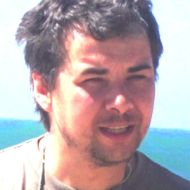MEG UK 2019 Conference
CBI researchers Alexandra Kuznetsova and Yulia Nurislamova made oral presentations athe MEG UK 2019 conference to have taken place April 15-17 in Cardiff, UK.

Julia Nurislamova, Reci-PSIICOS beamformer immune to correlated sources and forward model inaccuracies
Abstract:
MEG is a non-invasive neuroimaging technique with millisecond temporal and sub-centimeter spatial resolution, suitable for mapping rapidly changing cortical dynamics. Spatial resolution of MEG based functional cortical maps crucially dependents on the methodology used to solve fundamentally illposed inverse problem. Over recent years linearly constrained adaptive minimum variance (LCMV) beamformers have become a popular tool for mapping MEG sensor signals due to their spatial superresolution property [1, 2]. Being essentially spatial match filters the adaptive beamformers behave poorly in the environments with correlated sources which results in significant reduction of the signalto-noise ratio in the output signal and low contrast of cortical activation maps. We propose a novel beamformer approach that preserves spatial super-resolution but remains immune to the synchrony of neuronal source timeseries. Our method considers vectorized data covariance matrix as an element of the N2 dimensional vector space and applies to it the projection complementary to that described earlier in [3]. Thus, instead of suppressing power in the spatial leakage subspace, we solve the reciprocal task and emphasize it but suppress the contributions modulated by the off-diagonal terms of the source-space correlation matrix. We hence term our method ReciPSIICOS beamformer. We compared ReciPSIICOS algorithm with LCMV beamformer and weighted MNE source reconstruction techniques both using realistic simulation and real data. As our simulations show that novel beamformer has greater tolerance for the forward model inaccuracies and low SNR. [1] Van Veen B., van Drongelen W., Yuchtman M., Suzuki A. T. Localization of brain electrical activity via linearly constrained minimum variance spatial filtering //IEEE Transactions on biomedical engineering. 1997. 44. ‚ 9. ‚ 867-880. (edited) [2] Greenblatt R., Ossadtchi A., Pflieger M. Local Linear Estimators for the Bioelectromagnetic Inverse Problem // IEEE Transactions on Signal Processing. 2005. Vol. 53. No. 9. [3] Ossadtchi A, Altukhov D, Jerbi K. Phase shift invariant imaging of coherent sources (PSIICOS) from MEG data. Neuroimage. 2018 Aug 21. pii: S1053-8119(18)30731-6. doi: 10.1016/j.neuroimage.2018.08.031. [Epub ahead of print]
Aleksandra Kuznetsova, Traveling wave model for SOZ localization in MEG data.
Abstract:
Localization of seizure onset zone (SOZ) for patients with pharmacologically intractable multifocal epilepsy is the the major goal of presurgical diagnostics. Currently only about 70% of all patients become seizure-free after surgery, which is partly explained by inaccurate SOZ localization [3]. Novel approaches for detailed analysis of interictal recordings, especially noninvasive ones, are needed to improve the accuracy of the diagnosis. In this work we hypothesize that cortical activity giving rise to interictal spikes behaves like a wave [1, 4] and propagates over the cortical tissue with specific speed and in specific direction. To explore this we have developed a novel method that allows us to identify travelling wave parameters pertaining to individual spikes. We have shown, that wave prior based solution appears to generate useful information regarding the millimeter-scale spatial dynamics of interictal events and SOZ localization. We employed ASPIRE approach [2] to obtain a set of spatial clusters corresponding to irritative zones. One or several of these clusters potentially may be the SOZ. Then to explore the fine local spatial-temporal dynamics of individual interictal spikes we describe the underlying neural activity as a linear combination of precomputed basis waves propagating with different speeds and in different directions. We implement the LASSO technique [5] with positively constrained coefficients to find a minimal combination of basis waves sufficient to describe the interictal spike. The best solution is defined according to the coefficient of determination metrics. We applied the proposed methodology to the real interictal MEG data from two patients with multifocal epilepsy. We have found, that the irritative zones significantly differ by the percentage of spikes that can be described well with the travelling wave model. Intriguingly, clusters with the largest proportion of well-fitted spikes appear to coincide with brain regions removed during the surgery that had Engel I outcome. 1. Martinet L., Fiddyment G., Madsen J., Eskandar E., Truccolo W., Eden U., Cash S., Kramer M. (2017), Human seizures couple across spatial scales through travelling wave dynamics, Nature Communications, pp. 1-13. 2. Ossadtchi A., Baillet S., Mosher J.C., Thyerlei D., Sutherling W., Leahy R.M. (2003), Automated Interictal Spike Detection and Source Localization in MEG using ICA and Spatio-Temporal Clustering, Clnical Neurophysiology, vol. 115, no. 3, pp. 508- 522. 3. Schuele S., Lüders H. (2008), Intractable epilepsy: management and therapeutic alternatives, Lancet Neurol, vol. 7, pp. 514-624. 4. Tomlinson S., Bermudez C., Conley C., Brown M., Porter B., Marsh E. (2016), Spatiotemporal Mapping of Interictal Spike Propagation: a novel methodology applied to pediatric intracranial EEG recordings, Frontiers in Neurology, vol. 7, no. 229, pp. 1-12. 5. Tibshirani, R. (1996), Regression shrinkage and selection via the Lasso, Journal of the Royal Statistical Society, vol. 58, no. 1, pp. 267-288.
Date
18 April
2019
Authors
Aleksandra Kuznetsova
Yulia Nurislamova
Keywords


